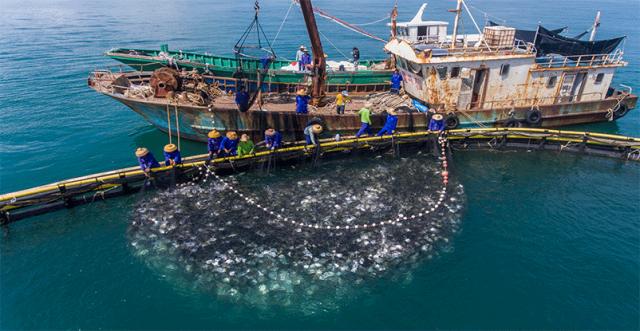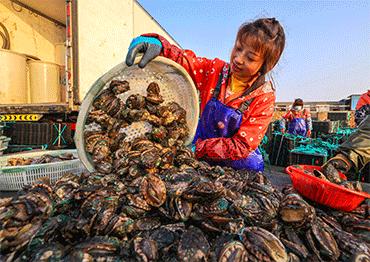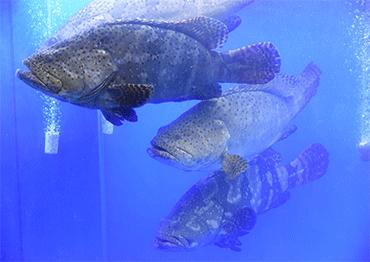Other fish species to have been successfully cultivated in deep-sea fisheries include the hybrid grouper, golden pompano and black kingfish.
Many varieties of grouper are suitable for deep-sea aquaculture. They have high economic value, tender meat and provide rich nutrition.
The first hybrid grouper to be approved by Chinese agriculture authorities in 2017 was the Hulong hybrid grouper, or tiger dragon grouper. It was a collaboration of more than 10 years between a research center, two universities and an aquaculture company, Professor Luo said.
Luo said this variety combines the excellent growth characteristics of its parent species, with a fast growth rate as the trait of its female parent, and a large body size as the trait of its male parent. The Hulong hybrid grouper is widely cultured off the southern Chinese coast, and accounts for around 70 percent of the grouper market in China. The total annual production of groupers in China is about 250,000 tons, with the Hulong hybrid grouper yields of 200,000 tons, ranking third in total output after the golden pompano, the large yellow croaker.
The Hulong hybrid grouper’s output and stable price creates a stable market. “The farm gate price for this variety hovers around 60 yuan (US$8) per kilogram, allowing fish farmers to make around 20 percent profit, and it’s popular with consumers across the country,” Luo said.
Another high-value grouper variety, the leopard coral grouper, is favored by fish culture farms due to its high market price in parts of China. This variety is mainly distributed in tropical and subtropical waters of the Indo-Pacific region and they like to live in coral reef areas. Cultivating this variety is more difficult and costs more to farm than a hybrid grouper, with stricter requirements for water temperature and quality. The farm gate price for this variety is around 300 yuan (US$41) per kilogram so fish farmers get more profits, Luo said. But so far it is only cultivated around Hainan Province, with an annual yield of 20,000 tons.
Luo cautioned that while deep-sea aquaculture for grouper species is viable, due to its relatively weak resistance to wind and waves, it is not suited to deep-sea and offshore cages. “But it can be a suitable breed for aquaculture vessels operating in deep-sea areas,” he said.
Research is ongoing in Fujian and Guangdong on cultivating two new hybrid grouper varieties, the Yunlong hybrid grouper and Qinglong hybrid grouper. Luo said both could potentially be cultivated in deep-sea aquaculture vessels, which contain breeding tanks and are considered safer than cages.
An example of recent success in deep-sea aquaculture is the golden pompano, which is gaining popularity, Luo said. It has strong swimming ability, allowing it to better adapt to powerful deep-sea currents, and is well-suited for freezing and processing. It is one of the main deep-sea cage culture varieties in southern coastal regions of China. In 2023, the annual output of golden pompano was 292,300 tons, exceeding that of the large yellow croaker and ranking first among marine fish culture varieties in China.
The golden pompano has a relatively fast growth rate in deep-sea aquaculture. Under appropriate breeding conditions, it can reach marketable size in a relatively short time, ranging from six months to up to one year, which helps improve culture efficiency and economic benefits.
Yet as more investors were attracted, fish farmers shifted to culturing golden pompano without securing sufficient markets for the species, leading to oversupply in 2024. Luo said that as there is not yet a stable large market and acceptance for domestic consumers, there were significant price fluctuations, and some aquaculture companies were overextended and went bust.
For years, Luo and his team have been researching and cultivating deep-sea aquaculture species that fit a mid-tier market price. The greater amberjack, also known as rock salmon, comes from the same family as the golden pompano. According to Luo, it has a substantial mouthfeel, yet remains tender and easy to chew. It is suitable for sashimi and can be grilled, baked or fried. “This variety, already popular in Japan for sashimi, isn’t really known in China,” Luo said, who believes cultivation should be encouraged for domestic consumers. “We need to ensure a good living environment, quality control, refrigerated transportation and make sure that chefs know how to cook it, so we’ll be fully prepared to embrace this emerging variety.”

 Old Version
Old Version



